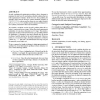Free Online Productivity Tools
i2Speak
i2Symbol
i2OCR
iTex2Img
iWeb2Print
iWeb2Shot
i2Type
iPdf2Split
iPdf2Merge
i2Bopomofo
i2Arabic
i2Style
i2Image
i2PDF
iLatex2Rtf
Sci2ools
117
click to vote
STOC
2004
ACM
2004
ACM
Boosted sampling: approximation algorithms for stochastic optimization
Several combinatorial optimization problems choose elements to minimize the total cost of constructing a feasible solution that satisfies requirements of clients. In the STEINER TREE problem, for example, edges must be chosen to connect terminals (clients); in VERTEX COVER, vertices must be chosen to cover edges (clients); in FACILITY LOCATION, facilities must be chosen and demand vertices (clients) connected to these chosen facilities. We consider a stochastic version of such a problem where the solution is constructed in two stages: Before the actual requirements materialize, we can choose elements in a first stage. The actual requirements are then revealed, drawn from a pre-specified probability distribution ; thereupon, some more elements may be chosen to obtain a feasible solution for the actual requirements. However, in this second (recourse) stage, choosing an element is costlier by
Related Content
| Added | 03 Dec 2009 |
| Updated | 03 Dec 2009 |
| Type | Conference |
| Year | 2004 |
| Where | STOC |
| Authors | Anupam Gupta, Martin Pál, R. Ravi, Amitabh Sinha |
Comments (0)

